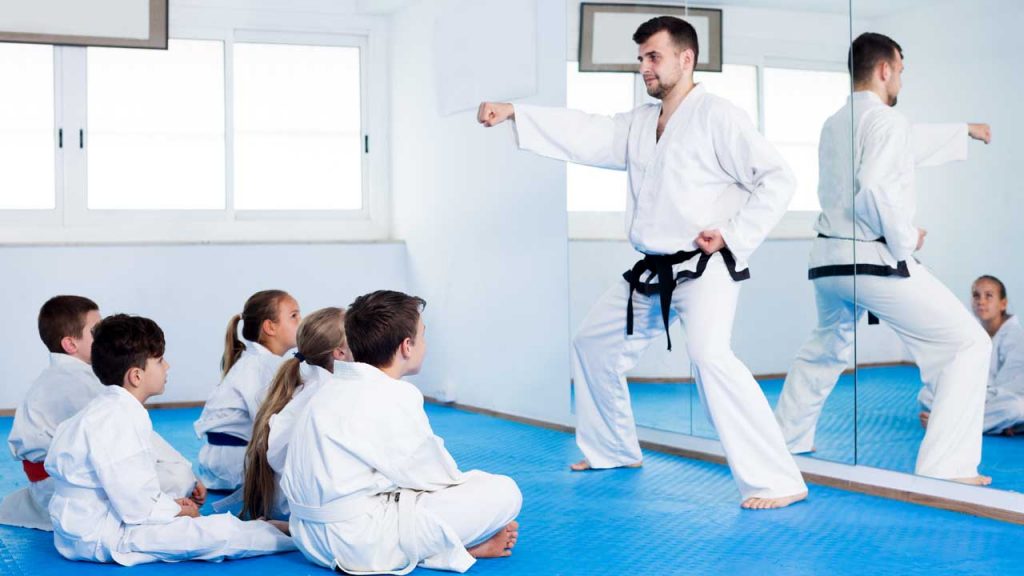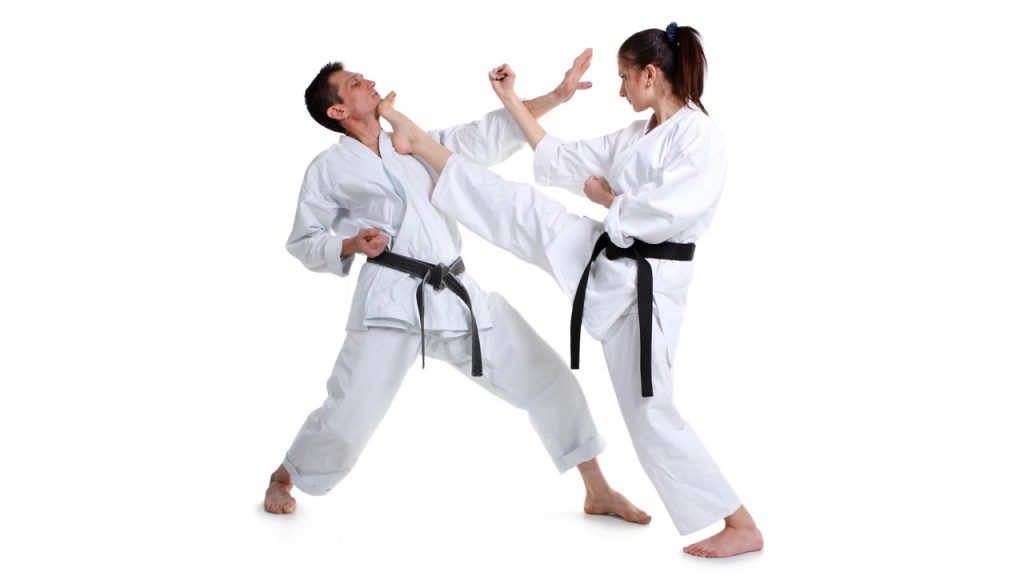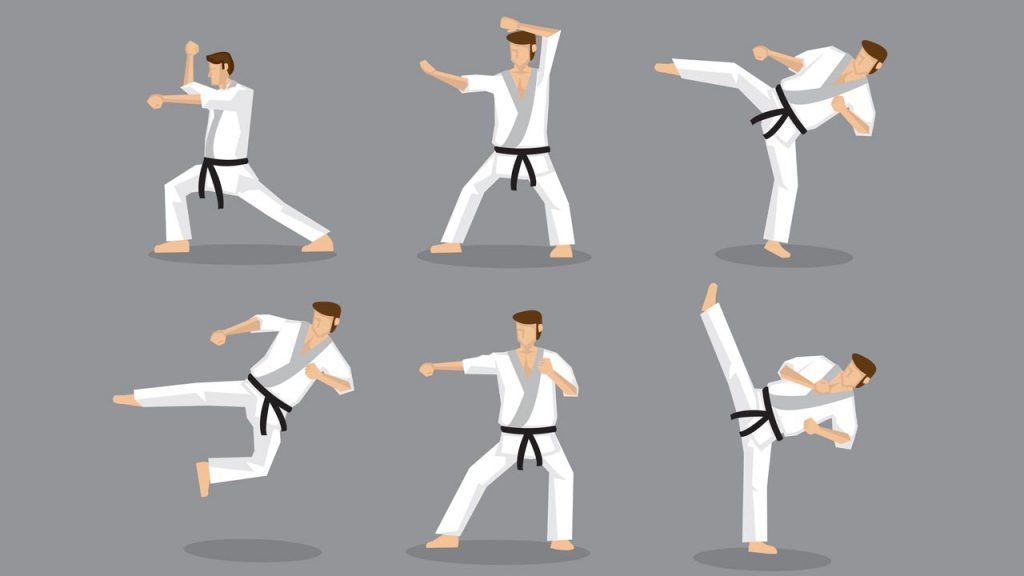How do you become a karate machine? You see those amazing fighters in martial arts movies or in competitions and have watched in awe as they decimate their opponents with a seemingly endless blur of techniques.
Can you ever hope to become that fast or that good?
Absolutely! You start in the very same place they started — at the beginning. There are really only a few basic karate moves. Everything else is built on top of that base. So, the best way to learn karate is to start with this list of karate moves for beginners.
Let’s get started!
Table of Contents
- Learning Basic Karate Moves
- Make a Fist
- 1. The Straight Punch: Choku Zuki
- 2. The Front Lunch Punch: Oi Zuki
- 3. The Front Kick: Mae Geri
- 4. The Side Kick: Yoko Geri
- 5. The Roundhouse Kick: Mawashi Geri
- 6. Upper Rising Block: Age Uke
- 7. Middle Block: Soto Uke/Uchi Uke
- 8. Downward Block: Gedan Barai
- The Best Basic Karate Techniques
Learning Basic Karate Moves
Before you can execute a cool karate move like the crane kick from The Karate Kid or perform complicated katas, you need to learn the most simple karate moves. Everything in the art is built off the basic moves.
It’s also important to learn the original names of the punches in Japanese. Karate is just as much about training the mind as it is about training the body. To that end, we’ll present the karate moves names in Japanese as well so you can start becoming familiar with them.
Make a Fist
Before we can get to punching, we’ve got to start with the most basic — making a fist. After all, if you make a fist incorrectly and strike something, you run the risk of breaking one of the relatively delicate 27 bones in your hand or fingers.
To make a fist, curl your fingers down until the tips of your fingers meet the palm of your hand. It should be super tight, enough that the pads of your fingers nearly touch the joint at the base of your fingers. Fold your thumb down neatly over the top of your index and middle finger. It will rest on the flat spot between the middle and last finger joints.
Some people will tell you to pull the thumb back and rest it on top of your curled index finger or even to tuck it inside the hand. However, both of these positions put you at a higher risk of breaking your thumb (not to mention they are a little uncomfortable).
Your fist should be tight, with no gaps or slack in the fingers. When you punch, aim to strike with the large knuckles of the index and middle fingers. Always have a straight wrist on impact.
Now we’re ready to go over the basic karate moves step-by-step.
1. The Straight Punch: Choku Zuki

The basic straight punch is one of the most used martial arts moves. You’ll see it used in many styles of martial arts. It holds a special spot in Karate, however, since Karate is seen as a very linear, almost choppy style. The straight punch is a favorite among karatekas and is incredibly powerful when done well.
To perform a straight punch, begin in a neutral stance. To punch with the right hand, send your punch out from a cocked position at your side, palm up. As you send the punch out, twist your hand so that the palm is facing down. Stop just short of completely extending your elbow and do not lock it or you run the risk of injury.
Step forward with the right leg at the same time and pull back your left hand to a ready position at your side. This push-pull effect adds more power to your punch when correctly timed.
Remember to strike with the two largest knuckles and aim for the center of your imaginary opponent’s chest. Kiai upon impact.
This seemingly innocuous little move is devastating when delivered by a trained hand. You can blast through boards in competition or destroy your opponent in a street fight with a properly executed straight punch.
2. The Front Lunch Punch: Oi Zuki
The front lunch punch is even more powerful than the straight punch, adding extra momentum from your body to the punch. The movement with your arms is basically the same — push, pull with your other hand, begin with the palm facing up twisting your fist as you punch, and don’t overextend your elbow.
However, you’re going to commit more to this punch. In other words, you’ll fall into a deeper stance. This adds more power to the punch but puts you in a rooted position for a couple of seconds. Use it to devastate a single opponent, if there’s a buddy behind you, you’ll have a hard time reacting quickly to another attack.
Instead of a casual step forward, lunge forward to a deep zenkutsu dachi, or front stance. Add an extra push with the hip and pectoral on the same side as the punching arm.
3. The Front Kick: Mae Geri
Karate is all about punching and kicking, right? We’ve got the basics of punching down, now let’s look at the basic kicks.
Kicks can be challenging. It is harder to maintain your balance and you leave yourself vulnerable for an instant while your foot is up in the air. However, the tradeoff is an incredibly powerful technique. Legs are stronger than arms and you have more reach with them as well.
The front kick is the easiest for maintaining balance. It can be quick and snappy and it’s relatively easy to surprise your opponent with a sneaky front snap kick.
From a fighting stance, chamber the kick by drawing your knee up until your thigh is at least parallel to the floor. You can use either the front leg or the back leg. Stretch your foot forward and pull your toes back as if you were wearing extreme stilettos so you strike with the ball of your foot.

Don’t strike with your toes or you could break them. Extend your foot forward and upward with exploding power to connect with your opponent’s chin. Kiai upon impact.
Regaining your balance and stance after a kick is just as important as the kick itself. To do this, draw your foot back into the same chamber position (knee up and thigh parallel to the floor). Then lower it back to the floor into a fighting stance.
This is the snappy version. The front kick can also be performed as a thrusting version to push your opponent back. Chamber the kick in the same way, but this time as you extend thrust forward with your hip as well. Aim at your opponent’s solar plexus and “push” him away from you.
You won’t be able to return to the same stance after thrusting forward, however, chamber the kick and put it on the floor in front of you to land in a balanced fighting stance.
4. The Side Kick: Yoko Geri
The side kick is an excellent attack and defense all at the same time. You literally line your body up behind a ridiculously powerful attack. When executed correctly and properly timed, there’s no way your opponent can get through your defense. They’re only hope is to evade, which you should not be giving them adequate time to do.
To perform the side kick, you need to first turn sideways. It’s just a quick quarter turn to the left if you’re kicking with your right leg or vice versa for the left.
From a fighting or ready stance, chamber the kick by lifting your knee as high as you can. Use the momentum from lifting your knee to turn at the same time and make sure that the toes on your supporting leg end up pointing behind you. Lean back slightly and rotate your foot up so that your lower leg is close to parallel with the floor.
Now you are spring-loaded and ready to send that leg exploding out at your opponent. When you do, be sure to turn your ankle so that you are striking with the “knife edge” of the foot. In other words, the pinky side of your foot. Kiai upon impact.
If you’ve done it correctly, you can now watch as your opponent crumples to the floor.
5. The Roundhouse Kick: Mawashi Geri
So far we’ve been talking about straight kicking and punching, but what about when you want to come at your opponent from the side? Let’s talk about one of the most iconic fighting moves next — the roundhouse kick.
The roundhouse kick is beloved for various reasons. It is quick and sneaky, yet still incredibly powerful. Many a fighter’s ear has been left ringing after being pummeled by a surprise roundhouse kick.
Begin in a fighting stance. Chamber the kick by raising your back leg and turning it over so that your hip and knee are parallel to the ground (or as close as possible). Your knee should be bent and your toes pointed so there is a straight line from your knee to the tip of your toes and your shin is tight.
Your lower leg is like a coiled spring in this position, ready to explode forward in a powerful strike. As you send your foot forward, go up on the ball of your standing foot, allowing it to rotate to point almost behind you.
Keep your hip pushed forward as you execute the kick for full force. You can do a faster kick without pushing the hip forward, but you will sacrifice a lot of power. Strike your opponent’s ear or ribs with the top of your foot. Kiai upon impact.
Bend your knee to rechamber the kick, rotate your standing foot back to the front, and put your leg back down into a fighting stance to finish the technique.
6. Upper Rising Block: Age Uke
No list of karate basics would be complete without the basic blocking techniques. As a defensive martial art, karate doesn’t attack first. However, it does deflect attacks and has no qualms about launching a devastating counterattack to end the fight.
The first block we’ll discuss is the upper rising block. This block can be used to deflect hammer punches, axe kicks, and any other attacks that may be coming down from above. It can also be used to push high punches safely upward and out of your face etc.
Begin with the blocking hand down at your abdomen as if you had a stomach ache, palm facing upward. Step forward into a front stance with the same leg as the blocking arm.
As you step, bring your arm up above your head, parallel to the floor, twisting your arm so that you end with your palm facing outward. Keep a fist to strengthen the position and let the sharp edge of your forearm bone take the brunt of the attack. From there you can deflect and move into an attack.
7. Middle Block: Soto Uke/Uchi Uke
The middle block or inside block is effective for deflecting strikes of all sorts to the body. It can be done two different ways, either from the inside out or the outside in.
The outside-in block (soto uke) puts your opponent inside your guard, which is an ideal position for you to mount a counterattack. To perform the block, bring your blocking arm up from the hip so that your forearm is roughly perpendicular to the floor. The palm of your hand should be facing you and you’ll make contact with the pinky finger side of your forearm as your arm rotates in from the outside.
In this position, you can easily use your other hand or foot to launch a devastating attack, perhaps even to your opponent’s face if they don’t cover themselves quickly.
The opposite block (uchi uke) moves from the centerline out, opening up the front of your attacker’s body. You’ll have to be aware of their other hand since you are also open, but you’ll have a nice choice of targets.
Bring your blocking arm up, sweeping it across your body and to the outside. Your palm should be facing you and you’ll catch the attack with the thumb side of your forearm. Follow it immediately with an attack to keep them from striking you with their other hand.
8. Downward Block: Gedan Barai
What if your opponent comes in low? Middle and high blocks are great for attacks coming at your head or torso but won’t help with sneaky hooks to the abdomen or uppercuts. These types of attacks are hard to stop outright, but you can deflect them with a low block.
Bring the blocking hand up by your ear on the opposite side. Bring the arm down sharply just ahead of your hip. Don’t extend the hand too far away from the body or you’ll lose strength. Use your hips and shoulders to help stabilize the block.
Your palm should be facing your body and you’ll strike your opponent’s arm or leg with the pinky side of your forearm. Timed correctly, the force of this block will redirect your opponent’s attack harmlessly away from your body.
It is also a good idea to transition into a back stance or cat stance while performing this block. These positions will help protect your groin and inner thighs as well from the incoming attack. Be careful with the cat stance, however, that you don’t become too unstable.
Here is a quick visualization of the basic blocking techniques:
The Best Basic Karate Techniques
We hope this karate moves list has been helpful to you. No matter where you are in your karate journey, it’s always good to go back and review the basics. Even karate masters with several stripes on their black belts go back and practice these foundational karate movements over and over. That’s how they get to be so amazing at their craft.
Wanna learn more karate basics, check out here: 14 basic karate stances.


